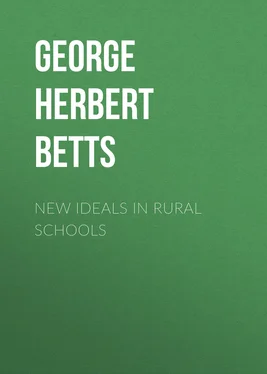George Herbert Betts - New Ideals in Rural Schools
Здесь есть возможность читать онлайн «George Herbert Betts - New Ideals in Rural Schools» — ознакомительный отрывок электронной книги совершенно бесплатно, а после прочтения отрывка купить полную версию. В некоторых случаях можно слушать аудио, скачать через торрент в формате fb2 и присутствует краткое содержание. Жанр: foreign_antique, pedagogy_book, foreign_edu, на английском языке. Описание произведения, (предисловие) а так же отзывы посетителей доступны на портале библиотеки ЛибКат.
- Название:New Ideals in Rural Schools
- Автор:
- Жанр:
- Год:неизвестен
- ISBN:нет данных
- Рейтинг книги:4 / 5. Голосов: 1
-
Избранное:Добавить в избранное
- Отзывы:
-
Ваша оценка:
- 80
- 1
- 2
- 3
- 4
- 5
New Ideals in Rural Schools: краткое содержание, описание и аннотация
Предлагаем к чтению аннотацию, описание, краткое содержание или предисловие (зависит от того, что написал сам автор книги «New Ideals in Rural Schools»). Если вы не нашли необходимую информацию о книге — напишите в комментариях, мы постараемся отыскать её.
New Ideals in Rural Schools — читать онлайн ознакомительный отрывок
Ниже представлен текст книги, разбитый по страницам. Система сохранения места последней прочитанной страницы, позволяет с удобством читать онлайн бесплатно книгу «New Ideals in Rural Schools», без необходимости каждый раз заново искать на чём Вы остановились. Поставьте закладку, и сможете в любой момент перейти на страницу, на которой закончили чтение.
Интервал:
Закладка:
Yet, in spite of these hopeful tendencies, the rural community shows signs of deterioration in many places. Rural population is steadily decreasing in proportion to the total aggregate of population. Interest in education is at a low ebb, the farm children having educational opportunities below those of any other class of our people. For, while town and city schools have been improving until they show a high type of efficiency, the rural school has barely held its own, or has, in many places, even gone backward. The rural community confronts a puzzling problem which is still far from solution.
Certain points of attack upon this problem are, however, perfectly clear and obvious. First , educational facilities must be improved for rural children, and their education be better adapted to farm life; second , greater opportunities must be provided for recreation and social intercourse for both young and old; third , the program of farm work must be arranged to allow reasonable time for rest and recreation; fourth , books, pictures, lectures, concerts, and entertainments must be as accessible to the farm as to the town. These conditions must be met, not because of the dictum of any person, but because they are a fundamental demand of human nature, and must be reckoned with.
What, then, is the relation of the rural school to these problems of the rural community? How can it be a factor in their solution? What are its opportunities and responsibilities?
The adjustment of the rural school to its problem
As has been already stated, the problem of any type of school is to serve its constituency. This is to be done through relating the curriculum, the organization, and the teaching of the school to the immediate interests and needs of the people dependent on the school for their education. That the rural school has not yet fully adjusted itself to its problem need hardly be argued.
It has as good material to work upon in the boys and girls from the farm as any type of schools in the country. They come of good stock; they are healthy and vigorous; and they are early trained to serious work and responsibility. Yet a very large proportion of these children possess hardly the rudiments of an education when they quit the rural school. Many of them go to school for only a few months in the year, compulsory education laws either being laxly enforced or else altogether lacking. A very small percentage of the children of the farm ever complete eight grades of schooling, and not a large proportion finish more than half of this amount.
This leaves the child who has to depend on the rural school greatly handicapped in education. He has but a doubtful proficiency in the mechanics of reading, and has read but little. He knows the elements of spelling, writing, and number, but has small skill in any of them. He knows little of history or literature, less of music, nothing of art, and has but a superficial smattering of science. Of matters relating to his life and activities on the farm he has heard almost nothing. The rural child is not illiterate, but he is too close to the border of illiteracy for the demands of a twentieth-century civilization; it is fair neither to the child nor to society.
The rural school seems in some way relatively to have lost ground in our educational system. The grades of the town school have felt the stimulus of the high school for which they are preparing, and have had the care and supervision of competent administrators. The rural school is isolated and detached, and has had no adequate administrative system to care for its interests. No wonder, then, that certain grave faults in adjustment have grown up. A few of the most obvious of these faults may next claim our attention.
The rural school is inadequate in its scope . The children of the farm have as much need for education and as much right to it as those who live in towns and cities. Yet the rural school as a rule never attempts to offer more than the eight grades of the elementary curriculum, and seldom reaches this amount. It not infrequently happens that no pupils are in attendance beyond the fifth or the sixth grade. This may be due either to the small number of children in the district, or, more often, to lack of interest to continue in school beyond the simplest elements of reading, writing, and number. It is true that certain States, such as Illinois and Wisconsin, have established a system of township high schools, where secondary education equal to that to be had in the cities is available to rural children. In other States a county high school is maintained for the benefit of rural school graduates. In still others, arrangements are made by which those who complete the eight grades of rural schools are received into the town high schools with the tuition paid by the rural school districts. The movement toward secondary education supplied by the rural community for its children is yet in its infancy, however, and has hardly touched the larger problem of affording adequate opportunities for the education of farm children.
The grading and organization of the rural school is haphazard and faulty . This is partly because of the small enrollment and irregular attendance, and partly because of the inexperience and lack of supervision of the teacher. Children are often found pursuing studies in three or four different grades at the same time. And even more often they omit altogether certain fundamental studies because they or their parents have a notion that these studies are unnecessary. Sometimes, owing to the small number in attendance, or to the poor classification, several grades are entirely lacking, or else they are maintained for only one or two pupils. On the other hand, classes are often found following each other at an interval of only a few weeks, thereby multiplying classes until the teacher is frequently attempting the impossible task of teaching twenty-five or thirty classes a day. Children differing in age by five or six years, and possessing corresponding degrees of ability, are often found reciting in the same classes. That efficient work is impossible under these conditions is too obvious to require discussion.
The rural schools possess inadequate buildings and equipment . The average rural schoolhouse consists of one room, with perhaps a small hallway. The building is constructed without reference to architectural effect, resembling nothing so much as a large box with a roof on it. It is barren and uninviting as to its interior. The walls are often of lumber painted some dull color, and dingy through years of use. The windows are frequently dirty, and covered only by worn and tattered shades. There is usually no attempt to decorate the room with pictures, or to relieve its ugliness and monotony in any way. The library consists of a few dozens of volumes, not always supplied with a case for their protection. Of apparatus there is almost none. The work of the farm is done with efficient modern equipment, the work of the farmer's school with inadequate and antiquated equipment.
While the length of the school year is increasing in the rural districts, the term is yet much shorter than in town and city schools . Many communities have not more than six months of school, and few more than eight. This shortage is rendered all the more serious by the irregular attendance of the rural school children. A considerable amount of absence on the part of the younger ones is unavoidable under present conditions when the distance is great and the weather bad. After all allowance is made for this fact, however, there is still an immense amount of unnecessary waste of time through non-attendance. Many rural schools show an average attendance for the year of not more than sixty per cent of the enrollment. Going to school is not yet considered a serious business by many of the rural patrons, and truant officers are not so easily available in the country as in the city.
Читать дальшеИнтервал:
Закладка:
Похожие книги на «New Ideals in Rural Schools»
Представляем Вашему вниманию похожие книги на «New Ideals in Rural Schools» списком для выбора. Мы отобрали схожую по названию и смыслу литературу в надежде предоставить читателям больше вариантов отыскать новые, интересные, ещё непрочитанные произведения.
Обсуждение, отзывы о книге «New Ideals in Rural Schools» и просто собственные мнения читателей. Оставьте ваши комментарии, напишите, что Вы думаете о произведении, его смысле или главных героях. Укажите что конкретно понравилось, а что нет, и почему Вы так считаете.











